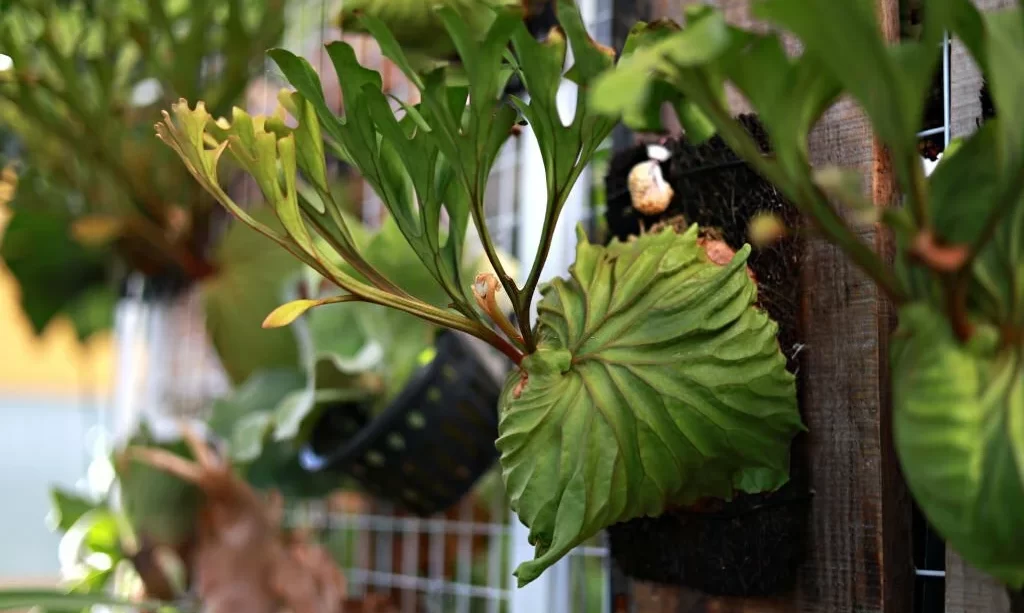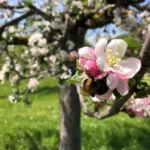Staghorn ferns, with their distinctive and fascinating fronds, are a captivating addition to any plant lover’s collection. Their unique growth habit and striking appearance make them an attractive choice for both indoor and outdoor settings. However, when a staghorn fern starts to show signs of decline and its once-lush fronds begin to wither, it can be a disheartening sight for any enthusiast. This article is your guide to rescuing and reviving a struggling staghorn fern. We will explore the steps and strategies you can employ to breathe new life into this captivating plant, ensuring that it thrives once more.
- Professional Liquid Fertilizer for: Ferns outdoor and as houseplants. Crocodile Fern (Microsorium musifolium), Lemon Button Fern (Nephrolepis cordifolia), Maidenhair Fern (Adiantum raddianum), Rabbit’s-Foot Fern (Humata tyermanii), Staghorn Fern (Platycerium bifurcatum), Bird’s Nest Fern (Asplenium nidus), Kangaroo Paw Fern (Microsorium diversifolium), Boston Fern (Nephrolepis exaltata) etc.
- This food for plants belongs to the latest generation of fertilizers.
- Very rapid effects, can be administered via the roots and as a foliar fertilizer. For 60-125 liters of ready to use liquid fertilizer
- Content: 250 ml, works as an economical concentrate. Simple dosage with the help of the cap.
- The fertilizers from the GREEN24 PROFI LINE were developed by gardeners of various departments and were evolved and produced based on the current knowledge in the field of propagation and cultivation of plants.
Diagnosing the Problem
The first crucial step in saving a dying staghorn fern is diagnosing the underlying problem. This step is essential, as a proper diagnosis is the key to providing effective care. Staghorn ferns can show distress for a variety of reasons, including issues with watering, lighting, pests, or disease.
To identify the cause of your staghorn fern’s decline, carefully observe the plant. Are the fronds turning brown or withering? Is the fern suffering from excessive dryness or waterlogging? Are there signs of pests or disease? Thoroughly inspect the fronds and the potting medium for any unusual signs.
Once you’ve identified the problem, you can proceed to the appropriate corrective measures, tailored to the specific issue plaguing your staghorn fern.
Adjusting Light and Location
Light is one of the most crucial factors in the health of your staghorn fern. These plants thrive in bright, indirect light. When they are exposed to direct sunlight, their fronds can become scorched, while insufficient light can cause them to wither.
To revive your ailing staghorn fern, consider relocating it to an area with suitable lighting conditions. Choose a spot where the fern receives filtered or indirect sunlight. This could be near a north-facing window or under the dappled shade of larger plants. Ensure that the fern is at an appropriate distance from windows to avoid scorching.
By making adjustments to the light and location, you provide your staghorn fern with the ideal conditions it needs to recover and thrive. In the following sections, we will explore additional steps and strategies to nurse your beloved staghorn fern back to health.
Watering and Humidity Management
Proper watering and humidity management are essential aspects of reviving a dying staghorn fern. These ferns have specific moisture requirements, and getting it right can make a significant difference in their recovery.
- Watering: Staghorn ferns should be kept consistently moist but not waterlogged. Water your fern when the top layer of the potting medium feels dry to the touch. Be sure to water thoroughly to ensure the roots receive adequate moisture. Avoid letting the fern sit in standing water, which can lead to root rot. Using distilled or rainwater is recommended, as these ferns are sensitive to minerals in tap water.
- Humidity: Staghorn ferns thrive in humid environments. To mimic their natural habitat, consider increasing humidity around your fern. You can achieve this by placing a tray of water near the plant or using a humidifier. Regular misting can also help maintain adequate humidity. Ensure that the fern is not exposed to drafts or excessively dry conditions, as this can lead to frond desiccation.
Pruning and Removing Dead Material
Pruning and the removal of dead or damaged material are crucial steps in revitalizing a struggling staghorn fern. Pruning helps redirect energy to healthy growth and improves the overall appearance of the plant.
- Pruning Dead Fronds: Carefully inspect the fern for fronds that are brown, withered, or dead. Using sharp, clean pruning shears, snip these fronds close to the base, taking care not to damage any healthy parts. Removing dead material will encourage the plant to allocate resources to new growth.
- Pruning Shield Fronds: In addition to pruning dead fronds, consider trimming or pruning shield fronds if they have become overcrowded or discolored. Trimming the shield fronds can improve air circulation around the fern.
Fertilizing and Nutrient Support
Proper fertilization and nutrient support are key to rejuvenating a staghorn fern and helping it regain its vitality.
- Fertilization: Staghorn ferns benefit from a balanced, water-soluble fertilizer formulated for ferns or orchids. During the growing season (typically spring and summer), apply a diluted, balanced fertilizer every 6 to 8 weeks. However, be cautious not to over-fertilize, as excessive nutrients can harm the fern.
- Nutrient Support: Apart from regular fertilization, consider providing additional nutrient support by using a foliar spray. This can be particularly beneficial for epiphytic staghorn ferns, as it allows them to absorb nutrients through their fronds. Use a balanced foliar spray, diluted according to the manufacturer’s instructions, and apply it to the fronds every 4 to 6 weeks during the growing season.
By following these guidelines for watering, humidity management, pruning, fertilization, and nutrient support, you can help your ailing staghorn fern regain its vibrancy and health. In the upcoming sections, we’ll delve into pest management, disease control, repotting, and other strategies to further nurture your beloved fern back to life.
- FULLY ORGANIC SEAWEED AND KELP: A seven species blend of Ascophyllum Nodosum, Palmaria Palmata, Ecklonia Maxima, Laminaria Saccharina, Chlorella Vulgaris, Arthrospira Platensis, and Chondrus Crispus.
- EXTRACTED TO PROTECT NATURAL ENZYMES: Clean Kelp’s unique processing techniques give the cleanest possible kelp extract. Get all the benefits of natural kelp enzymes and hormones without the non-nutritious fibrous pulp that gives other kelps their thick, brackish appearance. You can see the difference.
- SIMPLE AND SAFE TO USE FOR ALL PLANTS: Add to every watering, it’s that easy. No risk of over application, plants love kelp. Clean Kelp aids in every stage of growth for root and stem health.
- FOR BOTH PLANTS AND LAWNS: Add Clean Kelp to all of your houseplants, vegetable garden, and your lawn for healthy green plants.
- FORMULATED AND MADE IN THE USA: Designed by botanists and plant chemists. Bloom City chooses only the highest quality ingredient sources and manufacturing methods to create the world’s best craft growing nutrient systems
Pest Management and Disease Control
Pest infestations and diseases can be significant contributors to a staghorn fern’s decline. To nurse your fern back to health, you must address and manage these issues effectively.
- Pest Identification: Begin by closely examining the fern for signs of common pests, such as scale insects, mealybugs, or aphids. Identify the type of pest affecting your fern, as different pests require specific treatment approaches.
- Treatment Methods: Depending on the pest identified, employ appropriate treatment methods. For example, you can remove scale insects or mealybugs by gently scraping them off with a soft brush or cloth. For more severe infestations, consider using insecticidal soap or neem oil, following the manufacturer’s instructions. Regularly inspect your fern to ensure that the pests have been successfully eliminated.
- Disease Management: If your staghorn fern shows signs of fungal or bacterial infections, it’s essential to address these promptly. Remove the affected fronds using sterile pruning shears, ensuring that you dispose of the infected material properly. Improve air circulation around the plant to prevent future disease outbreaks.
Repotting and Medium Renewal
Repotting may be necessary for your staghorn fern if it has outgrown its current container or if the potting medium has become overly compacted. Proper repotting can provide a fresh start for your fern’s roots and support its recovery.
- Assessment: Before repotting, assess whether the fern truly needs a new pot. Signs include roots growing out of the container’s bottom or excessive root crowding. Repotting may also be necessary if the potting medium has become too dense, impeding drainage.
- Repotting Process: Choose a container that is slightly larger than the previous one, ensuring it has adequate drainage. Prepare a mix of orchid bark, sphagnum moss, and well-draining potting soil. Gently remove the fern from its old pot, shaking off excess soil, and place it in the new container with fresh potting medium. Be cautious not to damage the roots during this process.
- Aftercare: After repotting, water the fern thoroughly and place it in a location with proper lighting and humidity. Observe your fern for signs of recovery, and avoid over-fertilization during this period to prevent stress on the roots.
Conclusion
Reviving a dying staghorn fern can be a rewarding journey, and with the right care, it’s entirely possible to restore it to its vibrant, healthy state. Through diagnosis, adjustments in light and location, effective watering, humidity management, and pruning, you can address the root causes of its decline.
Additionally, proper fertilization and nutrient support, along with vigilant pest and disease management, will ensure that your staghorn fern not only recovers but thrives. Repotting, when necessary, provides a fresh start and a rejuvenated growing medium for your beloved fern.
With patience, care, and these comprehensive strategies, you can look forward to watching your staghorn fern flourish and regain its lush, green beauty. Your efforts will be rewarded with a thriving and captivating plant that graces your space with its unique charm.





